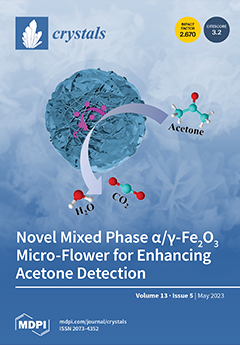The structural and luminescence properties of a new material, Ca
10.5−xNi
x(VO
4)
7, formed by substitution of a fraction of calcium by nickel, are studied as a function of the Ni content (
x). The powder
[...] Read more.
The structural and luminescence properties of a new material, Ca
10.5−xNi
x(VO
4)
7, formed by substitution of a fraction of calcium by nickel, are studied as a function of the Ni content (
x). The powder X-ray diffraction results for the polycrystals, synthesized using a solid-state reaction method, show that in the studied temperature range (300–1150 K), the structure of the unsubstituted material (space group
R3
c, whitlockite-
-Ca
3(PO
4)
2 structure type) is conserved up to the solubility limit,
x = 0.72(2), determined on the basis of variation of unit cell size with
x. The samples of nominal composition exceeding this limit contain a significant amount of the impurity phase.The structural refinements demonstrate that Ni atoms preferentially occupy the M5 site (one of the five independent Ca sites, M1–M5). The unit cell size was equally studied in the range of 300–1150 K, leading to the determination of the thermal expansion coefficients. It was found that with rising Ni content, the room temperature volumetric thermal expansion decreases from 41.80 MK
−1 (
x = 0.16) to 39.24 MK
−1 (
x = 0.66) and to 38.92 MK
−1 at the solubility limit, this reduction being in line with earlier reported data for x=0. In the unit cell variation, around 800–900 K, a weak anomaly is observed, detectable most clearly for the axial ratio; it is also visible at thermal expansion coefficient temperature dependence. Substitution of Ca by Ni ions reduces the optical band gap of Ca
10.5−xNi
x(VO
4)
7 from 3.56 (
x = 0) to 3.29 and 3.16 eV observed for Ni-containing samples (
x = 0.33 and 0.66, respectively). Observed bands in the absorption and photoluminescence spectra are assigned to electronic transitions in both VO
groups and Ni
2+ ions, confirming that Ni mainly occupies the M5 site. The band gap narrowing and decrease in photoluminescence intensity when the Ni concentration increases makes Ni-substituted compounds attractive for application, e.g., as photocatalysts.
Full article





